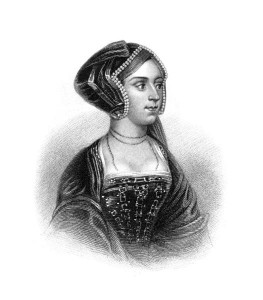 On 29th January 1536, the same day that Catherine of Aragon was buried, Henry’s second wife, Anne Boleyn, miscarried “a male child which she had not borne 3½ months”.
On 29th January 1536, the same day that Catherine of Aragon was buried, Henry’s second wife, Anne Boleyn, miscarried “a male child which she had not borne 3½ months”.
You can read more about this miscarriage, my examination of the primary sources and my thoughts on the deformed foetus theory in my article Anne Boleyn’s Final Pregnancy, but in this article I want to think about something a bit different. As you know, I’ve been working on a biography of George Boleyn, Anne’s brother, and my work on this book combined with my reading of Laura Andersen’s novel”The Boleyn King”1 – an “alternative history” novel about the reign of Henry IX, the son that Anne does not lose in January 1536 and who inherits the throne – made me think about the impact of Anne’s miscarriage.
Anne’s final miscarriage had devastating consequences for Anne, George, their parents and Boleyn supporters. Anne had lost the son that her husband Henry VIII was so desperate for. It was a devastating blow.
Henry VIII’s first wife, Catherine of Aragon, had experienced at least six pregnancies, losing two sons and two daughters through premature births or stillbirths, and providing Henry with a son who lived just fifty-two days and a surviving daughter, Mary. Henry had become convinced that these dead babies were proof that the marriage was wrong in the eyes of God, that it was an incestuous union because he had married his brother’s widow. He expected God to bless his new marriage with Anne Boleyn and Anne’s pregnancy in 1533 seemed to be proof of that, until she gave birth to a daughter. When Anne miscarried (or had a stillbirth) in 1534 and again in 1536, the increasingly paranoid Henry VIII can be forgiven for wondering if his second marriage was also cursed and incestuous, he had, after all, had a sexual relationship with Anne’s sister at one point in the past.
J.E. Neale writes of how Anne “miscarried of her saviour”2 that day in 1536 and I have to agree. The miscarriage cannot be blamed for Anne’s downfall, but a son would have kept her safe from those scheming against her. If that son had lived, Jane Seymour would have been just another notch on Henry VIII’s bedpost or a courtly love flirtation, and the Boleyn family would have continued to rise at court. The ten year-old prince would have become King at Henry’s death in January 1547, Anne Boleyn would have become Regent and it is likely that she would have been helped by her brother, George Boleyn, Lord Rochford, who may well have acted in some role similar to Lord Protector, just as Edward Seymour did in 1547. George would have had immense power and by helping the young prince to rule he could have helped to shape England.
The loss of that prince in January 1536 cost Anne Boleyn her life and George Boleyn his career, the prospect of a dazzling future and meteoric rise, and ultimately his life. George had risen at court due to his ambition and his talents, but it was his link to Anne which was to be his undoing. The miscarriage left Anne vulnerable and Boleyn enemies were waiting in the wings to take advantage of this. The Boleyn siblings fell from grace and were accused not only of treason but of committing incest, an abominable act. They were brutally executed in May 1536, suffering a huge miscarriage of justice. It was the end for these stars of the court.
It was not just Anne who suffered as a result of this miscarriage and the events of April and May 1536, it was her brother and four other innocent men, not forgetting their families and a two year-old girl left without a mother. If only things had been different.
This is one of the events you will find on the interactive timeline of the events of spring 1536 over at www.thefallofanneboleyn.com.
You can read my review of “The Boleyn King” on Tudor Book Reviews – click here.
Notes and Sources
- Andersen, Laura (2013) The Boleyn King
- Queen Elizabeth I, J.E. Neale